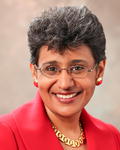31 May Taking A Little More Tissue After Breast Cancer Removal May Save Reduce Need For Further Surgery
 MedicalResearch.com Interview with:
MedicalResearch.com Interview with:
Anees B. Chagpar, MD, MSc, MPH, MA, MBA, FRCS(C), FACS, Associate Professor, Department of Surgery
Director, The Breast Center — Smilow Cancer Hospital at Yale-New Haven, Assistant Director — Global Oncology, Yale Comprehensive Cancer Center
Program Director, Yale Interdisciplinary Breast Fellowship
Yale University School of Medicine Breast Centerm
New Haven, CT,
Medical Research: What is the background for this study? What are the main findings?
Response: Every year in the US, nearly 300,000 women are diagnosed with breast cancer — the majority of these will have early stage breast cancer, and will opt for breast conserving surgery to remove their disease. The goal of this operation is to remove the cancer with a rim of normal tissue all the way around it (i.e., a margin), but sadly, 20-40% of women will have cancer cells at the edge of the tissue that is removed, often mandating a return trip to the operating room to remove more tissue to ensure that no further disease is left behind. No one likes to go back to the operating room — so we asked the question, “How can we do better?”. Surgeons have debated various means of obtaining clear margins. Some have advocated taking routine cavity shave margins — a little bit more tissue all the way around the cavity after the tumor is removed at the first operation. Others have argued that this may not be necessary; that one could use intraoperative imaging of the specimen and gross evaluation to define where more tissue may need to be removed (if at all) — i.e., selective margins. We conducted a randomized controlled trial to answer this question. We told surgeons to do their best operation, using intraoperative imaging and gross evaluation, and removing selective margins as they saw fit. After they were happy with the procedure they had performed and were ready to close, we opened a randomization envelope intraoperatively, and surgeons were either instructed to close as they normally would (“NO SHAVE”), or take a bit more tissue all the way around the cavity (“SHAVE”).
Patients in both groups were evenly matched in terms of baseline characteristics. The key finding was that patients who were randomized to the “SHAVE” group half as likely to have positive final margins and require a re-operation than patients in the “NO SHAVE” group. On their postoperative visit, we asked patients, before they knew which group they had been randomized to, what they thought of their cosmetic results. While the volume of tissue excised in the “SHAVE” group was higher than in the “NO SHAVE” group, the distribution of patient-perceived cosmetic outcomes were identical in both groups. Complication rate was also no different between the two groups. We will be following patients for five years for long-term cosmetic and recurrence outcomes.
Medical Research: What should clinicians and patients take away from your report?
Response: The key take away is that this relatively simple technique, which takes only a few extra minutes in the OR and can be done without any fancy technology or intraoperative frozen sections, can cut in half the positive margin and reoperation rate without altering patient cosmesis nor increasing complication rates. This is truly practice changing — it is hard to ignore level 1 evidence that such a simple technique can have such a big impact for patients.
Medical Research: What recommendations do you have for future research as a result of this study?
Response: There remain many unanswered questions — what will be the longterm outcomes in terms of cosmesis related to taking more tissue, particularly after radiation therapy? We are following patients for 5 years to answer this question. We found that in 12% of patients who had a negative margin (prior to randomization), more cancer was found in the cavity shave margins (which were taken solely due to the randomization). This calls into question the impact of finding this otherwise occult disease. Are there molecular markers that can predict this? Could this result in long term higher local recurrence rates? Or perhaps in the modern era of nearly ubiquitous systemic and adjuvant therapy, it is of no consequence? Again, we are following patients out for 5 years to try to obtain some of these answers. And finally, what are the implications of routine cavity shave margins in terms of cost and value? How will this impact our healthcare system? We are actively looking at this as well.
Citation:
A Randomized, Controlled Trial of Cavity Shave Margins in Breast Cancer
May 30, 2015DOI: 10.1056/NEJMoa1504473
MedicalResearch.com Interview with: Anees B. Chagpar, MD, MSc, MPH, MA, MBA, FRCS(C), FACS, Associate Professor, Department of Surgery, Director, The Breast Center — Smilow Cancer Hospital at Yale-New Haven, Assistant Director — Global Oncology, Yale Comprehensive Cancer Center, Program Director, Yale Interdisciplinary Breast Fellowship, Yale University School of Medicine Breast Centerm, & New Haven, CT (2015). Taking A Little More Tissue After Breast Cancer Removal May Save Reduce Need For Further Surgery
Last Updated on May 31, 2015 by Marie Benz MD FAAD
